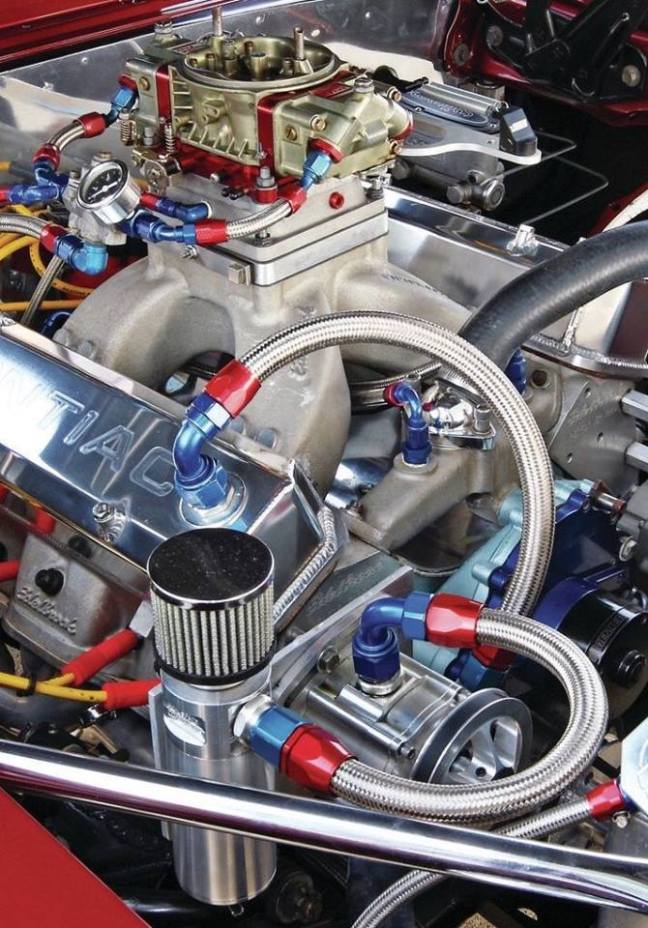Aerospace Components: Vacuum Pump
Bolt-On Horsepower
Aerospace Components vacuum pump systems relieve pressure and free up horsepower.
By Michael Galimi
Bolt-on power adders are prevalent in the street car market as many manufacturers produce easy-to-install forced induction components and, of course, nitrous oxide systems. The results are well documented with output increases as high as several hundred horsepower. This month I checked out a bolt-on power adder of sorts, well more of a power enabler, in the form of an Aerospace Components vacuum pump kit. It doesn’t offer the kind of big improvements as a turbocharger, supercharger, or nitrous kit but it does enable your race engine to perform better. Adding a vacuum pump is a simple bolt-on component, which isn’t normally associated with a racing engine either.
An Aerospace Component vacuum pump replaces the generic open element breathers or popular valve cover-to-exhaust hoses that are designed to help pull out crankcase gases. The Aerospace Components pump is driven by the crankshaft to create vacuum to relieve those pressures more effectively and help the engine create 20 to 40 more horsepower in the process. As I said, this isn’t a power adder but a bolt-on component that enables a race engine to generate more horsepower.

Aerospace Components sells vacuum pump kits to fit most popular big-block and small-block engines as well as universal setups. The vacuum pump mounts easily to the front of the engine, is spun by the crankshaft via the supplied mandrel and lower pulley setup, and a breather tank collects the spent gases and retains discarded oil.
“The pump does is exactly what it is suppose to do and that is to reduce windage and the affects of it,” said Keith Jones of Total Seal, a leading piston ring manufacturer who supplies piston rings to racers that span from the upper echelon of professional drag racing to daily drivers. Jones gave us a simple example that if one were to build a 565ci big-block Chevy that means there is 565ci of pumping effort above and below the piston rings. “All of that volume has to have a place to go and open breathers just aren’t going to get the job done,” he said. By adding a vacuum pump, it will help relieve the crankcase of that pressure.

The vacuum pump comes with a universal pulley combination that works for any application. An adjustable bleeder valve fine-tunes the vacuum that is pulled from the crankcase.
Ignoring the excessive windage in many engine combinations can lead to piston ring seal issues such as loss of the seal, blow-by, and—according to Jones—excessive oil consumption as the oil is held in suspension with what he called a “roping affect” that doesn’t drain back to the pan. “I’ve seen severe cases where the windage was so bad that it would blow oil out of the breathers,” he said. The excessive oil expelled out of the breathers is due to the valvetrain oil drainage being pushed back up the same hole that the crankcase is using to relieve pressure. Often times that is diagnosed as a ring seal issue but when in reality it is due to excessive windage, which the Aerospace Components vacuum pump is designed to reduce.
Matt Scranton, former NHRA Sport Compact champion and NHRA Pro Stock driver weighed in our on conversation. He currently operates Scranton Racing Development and utilizes the in-house dyno for various engine projects and manufacturer testing. He recently performed a back-to-back to test with an Aerospace Components vacuum pump on a class-restricted Bonneville Salt Flats land speed engine. “We gained right at 21hp with 12 inches of vacuum on a 461hp engine,” said Scranton. He continued to tell us that several 632ci engines that have come through the shop typically gain around 40hp with the addition of a vacuum pump. He continued, “the vacuum pump helps seal the rings better and allows you to add a lighter tension oil ring to help with power. It is also great for a nitrous engine to help control oil through the rings to prevent detonation.”

All kits come with AN12 ports on the vacuum pump and Aerospace Components supplies one 90-degree fitting, three straight AN12 fittings, and six-feet of stainless steel braided hose to give the end-user plenty of options for connecting the pump to the valve cover and plenty of hose to mount the breather tank in a variety of locations under the hood.
The Aerospace Components vacuum pump is made from high-quality 6061-T6 billet aluminum, including the carrier for low rotational mass. The one-piece shaft is also 6061-T6 billet aluminum and offers zero run-out while rolling on double-sealed ball bearings. The vanes are made from carbon fiber for durability and light rotating weight. All pumps come with a properly sized pulley and Aerospace Components offers mandrels to fit any engine application. The vacuum is regulated through an adjustable relief valve. Aerospace Components does offer various kits to fit popular engines, which includes the vacuum pump, engine-specific brackets, mounting hardware, hose and fittings to attach the pump to the valve covers and billet breather tank (included), relief valve, and other supporting components. All of the components are made in the U.S.A.

Here is the relief valve that attaches to the pump and allows the user to fine tune the vacuum that the Aerospace Components pump is removing from the crankcase. Typically a high-rpm engine will need to bleed off a greater amount of air to regulate the crankcase vacuum because the pump will be turning at a much higher rpm since it is connected to the engine.
“We go back to 1996 with Aerospace Components—the parts are high-quality, they fit, they work, and they are reliable,” said Scranton. And with 20-40hp gains normally seen with the Aerospace Components vacuum pump, bolt-on horsepower isn’t just a term regulated to the forced induction/nitrous oxide injection power adder market.
